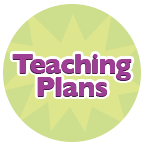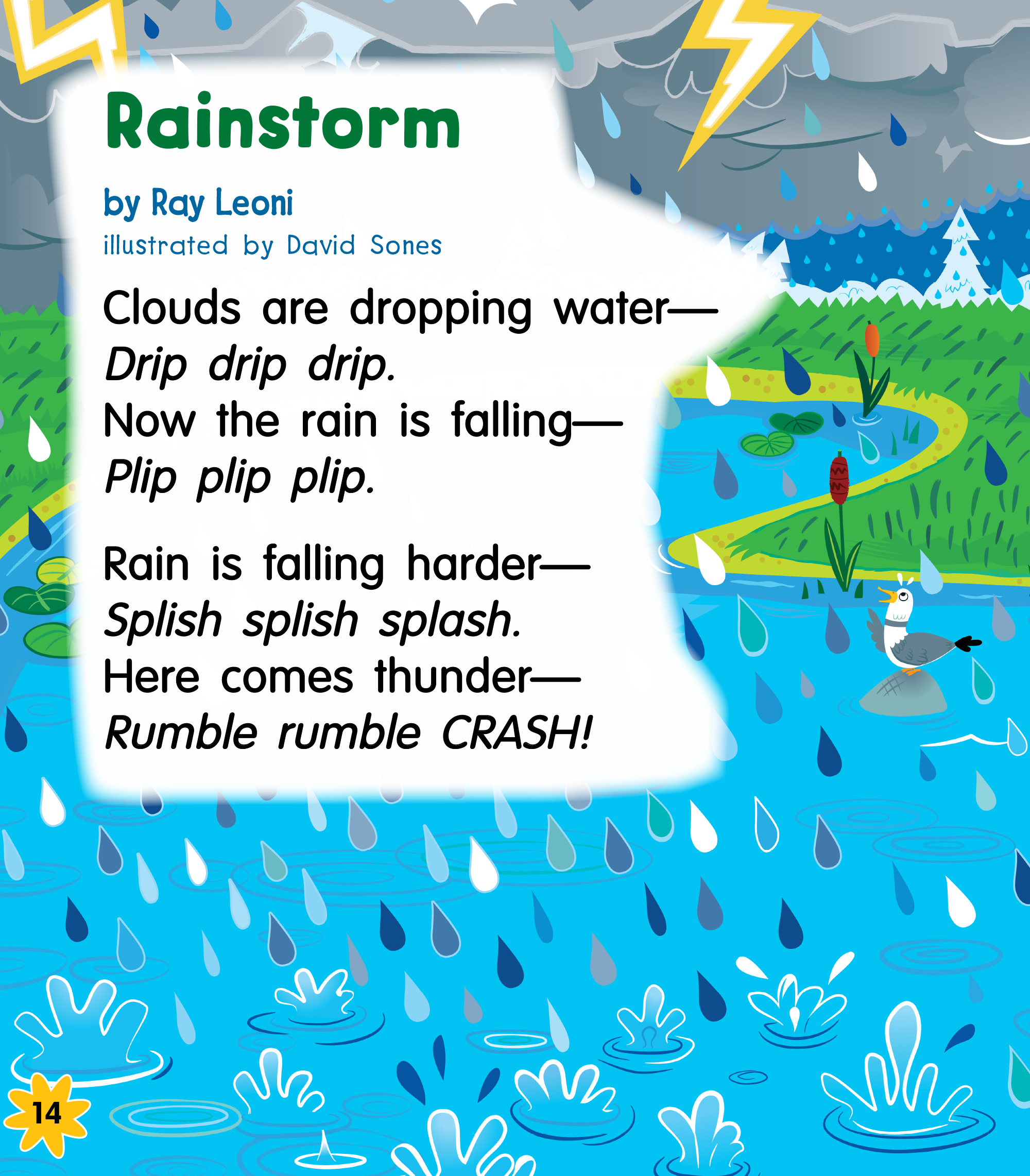Illustrated by David Sones
Text Type: Fiction: Poetry—rhyming poem
Oral Language Teaching Strategy: Promote Piggy-Backing Encourage the expansion of conversation through ‘piggy-backing’ (adding to another person’s ideas).
Time: 20 minutes
Materials:
– All Together Now, page 14
–
turtle puppet
–
Media Key or Online: “Rainstorm” audio
Grouping: whole class and partners
Assessment: Kindergarten Oral Language Assessment Scale See especially the section on Phonological and Phonemic Awareness.
FIRST READING
BEFORE READING
-
Today we’re going to learn a poem about a rainstorm. I love rain because I love to splash around and swim in the water.
Show students the double-page illustration that includes the poem. Use the turtle puppet to read the title and introduce the topic of the poem.
Activating and Building Background Knowledge
-
Rainstorms can be noisy! What sound do you hear when raindrops hit a puddle of water? (‘plip plip plip’) Do you see the splashes as the rain is falling in the picture? Have you heard the rain make that sound?
If students need support in discussing the concepts of rain and rainstorms, use the illustration to introduce applicable vocabulary, such as ‘raindrops,’ ‘splashes,’ ‘thunder,’ ‘lightning.’ Invite students to share different sounds they might hear during a rainstorm. [Making connections]
- As students share ideas, model how to expand on (‘piggy-back’ on) someone else’s ideas to encourage conversation.
Student: I’m scared of thunder.
Teacher: Have you heard the thunder crash and rumble? Sometimes it can be loud.
Setting a Purpose
-
Join in reading with me as soon as you like. Listen for the different sounds of the rain and thunder.
Tell the students that you are going to read the poem to them and that they should listen and join in as soon as they like. Ask them to think about the different noises the rain and thunder make as they listen. [Analyzing]
DURING READING
- Read the poem to students, encouraging them to read along, especially as the sound words are repeated.
- Focus on comprehension by offering prompts:
- What is the water called when it is falling? [Analyzing/inferring]
- What different sounds does the rain make when it falls? [Inferring]
- What makes the rumbling and crashing sound? [Analyzing/inferring]
- Do you think the sounds of the rainstorm would get louder as the poem goes on? Why or why not? [Analyzing/inferring]
Adding Playful Movements
-
Listen as I snap my fingers so it sounds like rain. If snapping is too tricky for you, rub your fingers together like this. I’ll read the poem as we do the actions together. Stand up, watch what I do and join in when you can.
Have students stand up and teach them actions to accompany the poem (you will have to put down the puppet to do this). Introduce each action separately and demonstrate it as you say the accompanying words. Encourage students to try making the sounds as they say the words, as modelled by you: - Clouds are dropping water—
Drip drip drip.
(snap fingers; or, just rustle fingers against thumbs) - Now the rain is falling—
Plip plip plip.
(rub palms together to make swishing noise) - Rain is falling harder—
Splish splish splash.
(drum thighs with flat hands) - Here comes thunder—
Rumble rumble CRASH!
(stomp feet lightly one by one, then jump and land on CRASH)
AFTER READING
-
I love all the different sounds of a rainstorm! What sounds did you notice as we read the poem?
Revisit the purpose for reading by using the puppet to ask students what different noises the rain and thunder made in the poem. Students may want to imitate the sounds using their mouths or use descriptive words. [Analyzing]
- You may wish to conclude the lesson by rereading the poem with actions, encouraging students to participate.
SECOND AND FURTHER READING
The students will want to reread “Rainstorm.” During further lessons, consider including a balance of ideas from the following areas:
Engaging in Playful Language Activities
- Divide the students into two groups. Have one group read the first verse and the other group read the second verse. Then reverse the groups so that each reads the alternate verse. You may also wish to have one group read the poem, while the other group makes the sound effects, then reverse the groups.
- Have the students read the poem, adjusting the volume of their voices to reflect the gradually noisier storm. Students can start with gentle whispers and become louder and louder, ending with a shouted “CRASH” at the end.
- Together with students, brainstorm full-body actions for students to act out the rain (e.g., squatting down slowly, then squatting quickly, then splatting belly-first on the ground, then wriggling and jumping). Divide students into four groups, one for each action, and have each group act out a rainstorm noise as you read the poem.
Extending Comprehension
- Ask students to share what they noticed about the volume of the noises as the poem progressed (they got louder). Discuss how the storm would get quieter again as it passes by. You may wish to reread the poem in the reverse order, having students do the accompanying actions.
- Invite students to share with an elbow partner what they would do if they were caught outside in a rainstorm (get an umbrella or raincoat, go inside if they heard thunder). Encourage students to ‘piggy-back’ on one another’s ideas in order to expand their conversations.
- Display the digital cloze version of the text on the Media Key. Working with the whole class, or with a small group, reread together and encourage students to supply the missing words (spaces for words highlighted in yellow). You may decide to pause to consider word predictions and prompt, “Does that make sense?” or “Does that sound right?” Then click on the colour-highlighted spot to reveal the word, saying, “Let’s check that out.” An option on the tool bar allows you to create your own cloze versions of the text to meet the needs of the students you are working with. Click on the ‘Help’ button to find out how to use the different features of the digital texts.
Developing Phonological Awareness
- Ask students to clap the syllables in the two-syllable words ‘dropping,’ ‘water,’ ‘falling,’ ‘harder,’ ‘thunder,’ and ‘rumble.’
- Focus on the sounds of the rainstorm with students, substituting the initial sounds with other consonants (e.g., instead of ‘Drip drip drip,’ say ‘Flip flip flip’; instead of ‘Splish splish splash,’ say ‘Flish flish flash’; instead of ‘Rumble rumble CRASH’ try ‘Tumble tumble SMASH’).
Enriching Print Concepts
- Track the print as you read and reread the poem. Use the turtle puppet to emphasize movement to a new line.
- As the poem becomes more familiar, ask students to take turns in tracking the print.
- Emphasize the concept of ‘word’ by asking the students to drum their thighs with flat hands once for each rain noise (‘drip,’ ‘plip,’ ‘Splish,’ ‘splash’) and to stomp once lightly for each word in ‘Rumble rumble CRASH.’
- Use a word frame (e.g., Wikki Stix bent around a word, a cut-out cardboard frame, or a piece of coloured acetate) and look at selected words such as ‘rain,’ ‘are,’ ‘the,’ ‘thunder,’ ‘is.’ Clap the number of letters in each word. (Concepts: A word is made up of letters; some words are long, some are short.)
- Look at the capital and small ‘Pp’ in ‘Plip, plip’ and the capital and small ‘Ss’ in ‘Splish, splish.’
- Ask students to show where in the text the rainstorm sound words are. Point out that this text looks differently (it is italicized) to show that these are sounds. You may also wish to note that capital letters are used in the last word to show that it should be read louder than the other words.
FOLLOW-UP IN CENTRES
- Place the big book and turtle puppet at a centre and encourage the students to reread the poem. Use the fluent reading provided on the Media Key or online to support students as they reread.
- You could include other books, poems, and images about rainstorms and other weather in appropriate centres throughout the room, such as the reading centre, water table, or the block centre. Encourage students to share their findings and interesting images with other students.
- Students can paint pictures of rainstorms to share with classmates during group sharing time.
- Students may use different materials (e.g., instruments, scrap materials) in a centre to make their own sound effects for a rainstorm or other weather phenomenon.
- Make sounds from the natural world (e.g., weather, waterfalls, animal noises) avaiable at the listening centre for students to experience.

